Prospecting & Detecting
Gold in The Midwest--Part I
December 2019 by Alex Dolbeare
Gold has been found in almost every state in the US, although it has not always been found in economic amounts. Still, some of the yellow metal has been found in varying amounts in many states, including the Midwest. The central part of this nation, known as the Midwest, is no stranger to gold discoveries. In some cases gold has been found in economic amounts and has even spurred some minor gold rushes.
The Midwest includes Illinois, Indiana, Iowa, Kansas, Michigan, Minnesota, Missouri, Nebraska, North Dakota, Ohio, South Dakota and Wisconsin. In this article we will take a close look at why gold is found in the Midwest, and in following articles we will look state-by-state at locations where gold has been found, along with popular prospecting locations, historic production, and why the gold is found in each location.
My journey into gold prospecting in the Midwest started shortly after I moved to Indiana from California. Having grown up prospecting for gold in California, Nevada and Arizona, I really didn’t have much knowledge about prospecting in the Midwest; in fact, I found out about gold in Indiana purely by accident.
On a back road excursion after moving to the Midwest, I stumbled onto a picturesque little store alongside a creek in the rolling hills of south-central Indiana. When I went inside to find out where I was, I noticed that they had various gold pans and other pieces of gold recovery equipment for sale. In addition to getting directions I inquired about the gold prospecting equipment and why they had it. The proprietor of the Gatesville Store, Robin Stevens, told me that people find gold in the creek all the time and that people come from other states just to prospect for gold there. “Gold? Here?” I thought.
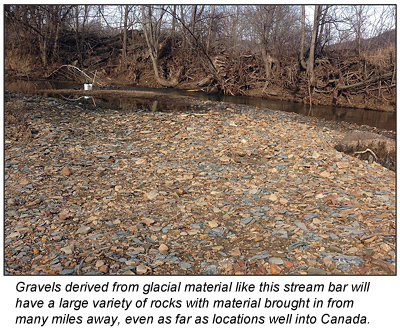 Since I wasn’t in any kind of a hurry, I decided to purchase a gold pan and go out to the creek to see what I could find. Once at the creek I panned my first sample and it revealed about ten little colors of gold in my pan. This was a surprise. It was enough to pique my interest, and I returned the following weekend to spend some real time prospecting there. Over the next few years I spent much of my free time learning about gold all across the Midwest and heading out to prospect various areas.
Since I wasn’t in any kind of a hurry, I decided to purchase a gold pan and go out to the creek to see what I could find. Once at the creek I panned my first sample and it revealed about ten little colors of gold in my pan. This was a surprise. It was enough to pique my interest, and I returned the following weekend to spend some real time prospecting there. Over the next few years I spent much of my free time learning about gold all across the Midwest and heading out to prospect various areas.
Glacial Gold
So why is there gold found in much of the Midwest? In most of the Midwestern states, gold that is found does not directly erode from lode deposits found within the area. Rather, the gold found is a result of re-concentration in the form of placers from glacial moraines and other glacial features. These moraines cover several areas in much of the Midwest.
The moraines were left from various periods of glaciation during the Ice Ages. The moraines were formed when material was pushed southward from Canada by glaciers. The ice then receded during the Quaternary Period, leaving those glacial gravels behind. During this time there were multiple events of glacial action. The concentrated till pushed and left from receding glaciers became moraines, drumlins, kettles, and eskers. Some of these glacial features were moved from great distances originating in Upper Canada southward at varying degrees into what is now the Midwest region. In this till left by the glaciers are many minerals, including gold, diamonds and other semi-precious stones.
Gold is rarely found in appreciable amounts in the moraines and other glacial features themselves, rather the gold is concentrated along rivers, creeks, drainages, and ancient water flows from past receding glaciers that cut through the moraines. Gold-bearing quartz cobbles are also occasionally found within the glacial till. Early prospectors thought these quartz cobbles were from nearby lodes, but no lodes where ever found.
Gold can potentially be found in all the glaciated areas of the Midwest, but to find it in any appreciable amount one needs to look to areas where the gold gets concentrated by more recent water flows.
Lode Deposits
Placers resulting from glaciation are not the only sources of gold in the Midwest. Lode deposits do exist, but only in a few areas. Michigan, known for its copper deposits in the Keweenaw Peninsula, also produced gold as a byproduct from the same mines. Close to some of the great copper mines in nearby Marquette County, numerous lode gold prospects and some larger gold mines had significant production. The Ropes gold mine discovered in the early 1880s operated for 14 years and produced $645,792 in gold and silver. Later, the Ropes mine was reopened and produced gold into the late 1980s. In other locations of the Upper Peninsula, the Lake Superior mine and Michigan mine produced spectacularly rich specimens of gold in quartz.
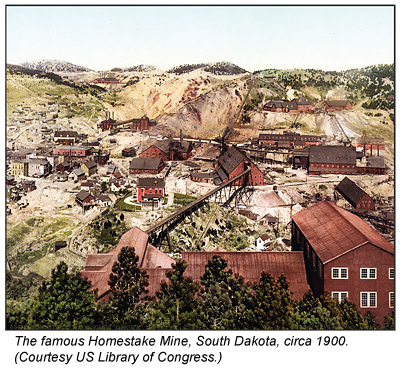 In the Black Hills of South Dakota, prospectors in 1874 discovered placer gold in many drainages and a rush quickly ensued. Shortly after the rich placer discoveries were made, prospectors located a number of rich ledges that were the source of the placers in Deadwood Creek. Soon after, a larger rush came to the area and several lode mines were staked and operated and many were significant producers. The Homestake mine near Lead has a long history of production. Lode deposits in the Black Hills region are still being explored by large mining companies. By 1971, estimated gold production from the lode mines of the region was almost 35 million troy ounces.
In the Black Hills of South Dakota, prospectors in 1874 discovered placer gold in many drainages and a rush quickly ensued. Shortly after the rich placer discoveries were made, prospectors located a number of rich ledges that were the source of the placers in Deadwood Creek. Soon after, a larger rush came to the area and several lode mines were staked and operated and many were significant producers. The Homestake mine near Lead has a long history of production. Lode deposits in the Black Hills region are still being explored by large mining companies. By 1971, estimated gold production from the lode mines of the region was almost 35 million troy ounces.
In west central Kansas there is an area of Cretaceous age shale beds where gold has been found, though in rather small amounts. The Carlile shale is a bed of gray-to-black shale 300 feet thick, which is soft at the surface and greatly decomposed. The shales that contain gold were pyrite-rich and at the surface the iron oxidized the shale to a brownish yellow color. The quantities of gold in the shales were never large enough or rich enough to spur any kind of major mining activity though there were rumors of assays up to 15 ounces per ton from the gold ore. This is speculated to be purely promotional to gain interest into the area and no other assays proved to be that good.
Beach Deposits
Though the Great Lakes are not oceanic or subject to great tidal influences, they are large enough to develop large, powerful waves and surges that can winnow away lighter sands and push and concentrate heavy black sands with gold along some of the beaches much like the ocean can.
Lake Superior is the most well-known lake for beach placers, though some sources say small amounts can be found on select beaches of the other Great Lakes as well. Since the Great Lakes Region was glaciated, much of the gold is initially deposited by past glaciers, though it is possible for some lode-derived placers to show up along beaches in the Upper Peninsula. The wave action along beaches ultimately concentrates gold in recoverable amounts, and the areas to be looked at for prospecting should have large areas of heavy black sand.
_______________
In following articles of this series, I will break down places to find gold state-by-state, which can hopefully lead to some prospecting success in locations near you if that is the part of the country where you live. As with any kind of prospecting, one should thoroughly be aware of local laws regarding gold prospecting. Laws can vary greatly from state to state or even from one location to another in a given state. A great way to gain knowledge of these rules is by joining a local gold prospecting club. Many times these clubs may already have access to good areas for prospecting.
_______________
Editor’s Note: In preparation for this series, read “Glaciers and Placer Gold Deposits” by Chris Ralph (November 2016 issue) for an in-depth look at glacial deposits.
Hunting for Gold in the Quartzsite Area of Western Arizona
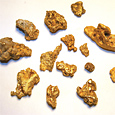 Winters are a great time to explore the hills in the area of the Middle Camp, Oro Fino and La Cholla placers on the southern flank of the Dome Rock Mountains.
Winters are a great time to explore the hills in the area of the Middle Camp, Oro Fino and La Cholla placers on the southern flank of the Dome Rock Mountains.
Tips and Tricks: A Dredging Tip for Clearing the Tailings Pile
After a short time, the tailings pile can get very large, and can actually block the downstream end of the sluice box.
Where to Find Gold in Indiana—Part II
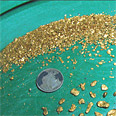 Part I of the article addressed modern placer gold deposits. This second installment will address “ancient” flood deposits.
Part I of the article addressed modern placer gold deposits. This second installment will address “ancient” flood deposits.
Detecting Alone -- What to Look For
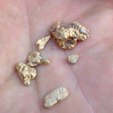 I figure there are a lot of new people out there who have the same question. I will try to give some answers that hopefully will give you more confidence in finding your own spots.
I figure there are a lot of new people out there who have the same question. I will try to give some answers that hopefully will give you more confidence in finding your own spots.
Pickers and Nuggets
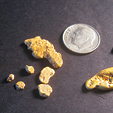 Mike and I each selected a side of the creek and started to work our way upstream. We both worked the water and sides of the creek, and better than half the gold found in this area is in the water.
Mike and I each selected a side of the creek and started to work our way upstream. We both worked the water and sides of the creek, and better than half the gold found in this area is in the water.
Getting A Successful Start in Metal Detecting for Gold
Once you have a detector, learn how to use it and get out in the field—you can’t find anything with it in your garage.
The Dredge Report
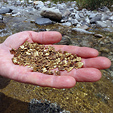 As a plaintiff in one of the lawsuits, I’m not allowed to talk about specifics in the court-ordered negotiations currently underway in San Bernardino. However, I do want to let you know we are making progress…
As a plaintiff in one of the lawsuits, I’m not allowed to talk about specifics in the court-ordered negotiations currently underway in San Bernardino. However, I do want to let you know we are making progress…
Subscription Required:
The Bawl Mill
• Ask The Experts - How do I obtain a map of Montana gold & sapphire gravel bars?
• Ask The Experts - How do I process this white quartz with black striations?
• Ask The Experts - Does gravel + bedrock = gold?
• Back to Green Valley--With A Sluice
• A Lesson In Underwater Sniping
• More Fiddling While Forests Burn
• Achieving Accurate Metal Detector Discrimination
• My New Passion--Crystal Hunting
• The Half-Mile Claim
• Melman on Gold & Silver
• Mining Stock Quotes and Mineral & Metal Prices
• Gold Prospecting for Better or Worse: White Knuckle Mining
Free:
Legislative and Regulatory Update
• Unique Rare Earth Mine in Texas
• PLP Update: Another Suction Dredge Case Heading to the US Supreme Court








